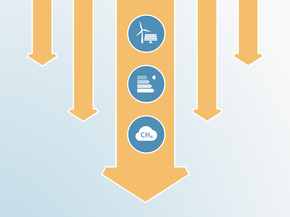Current Policy Projections
All sectors
With currently implemented policies, The Gambia says it expects, through deploying renewable energy, to achieve emissions levels (excluding LULUCF) of 3.75 MtCO2e in 2030 instead of 3.85 MtCO2e in its BAU in 2030. This is equivalent to an increase of around three times above 1990 levels.
To achieve its conditional and unconditional NDC targets, the government aims to set up a framework for renewable energy development. In 2013, the Gambian Parliament passed the New Renewable Energy law (Government of The Gambia, 2013) and tasked the Public Utilities Regulatory Authority to define and implement the rules for pricing the feed-in tariff (FiT) for renewable electricity. The rules state that the power purchase agreement will be valid for 15 years from plant commissioning, and tariffs will be published three years in advance to give certainty to project developers (Public Utilities Regulatory Authority, 2014). These tariffs are subject to adjustment based on local inflation and the dollar exchange rate. The new law establishes a renewable energy fund to develop renewable energy infrastructure, capacity building, research and development, local equipment production and promotion. No recent information is available on how much renewable energy capacity has been installed under the New Renewable Energy law as of August 2017.
To meet its conditional NDC targets, the Gambian government also announced a Sustainable Energy Action Plan in 2015 (Government of The Gambia, 2015), including the National Renewable Energy Action Plan (NREAP) and the National Energy Efficiency Action Plan (NEEAP). The NREAP sets targets for renewable energy capacity deployment until 2020 and 2030 as well as the instalment of solar thermal systems. The NEEAP outlines measures to increase energy efficiency until 2030, including the gradual phase-out of incandescent bulbs and the instalment of efficient charcoal production technologies. No recent information is available on the current implementation status of either actions plan. Since these measures will be implemented only if The Gambia receives international funds and technical support, we do not include them in the current policy projections.
In 2012, the Gambian government proposed a list of ten NAMAs to be implemented in the energy, forestry, agriculture and waste sector (Government of The Gambia, 2012). As of August 2017, most of these NAMAs are still under development and seek support for implementation (NAMA Database, 2017; UNFCCC NAMA Database, 2017). Due to this uncertainty on their current implementation status, the proposed NAMAs have not been included in the current policy projections.
Besides the government’s projections in the NDC, there are no other recent emissions projections for The Gambia, thus CAT could not refer to other independent data sources. The quality of historical data is also poor (see ‘Assumptions’ section).
Further analysis
Latest publications
Stay informed
Subscribe to our newsletter




